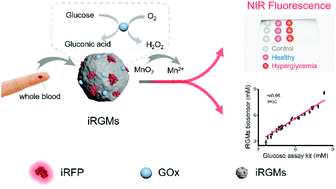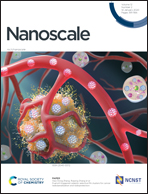Biomineralization synthesis of a near-infrared fluorescent nanoprobe for direct glucose sensing in whole blood†
Abstract
A near-infrared (NIR) fluorescent nanoprobe that enables to circumvent the interference of background absorption and fluorescence in whole blood was developed for the direct sensing of blood glucose. Here, NIR fluorescent protein (iRFP) and glucose oxidase (GOx) were collectively deployed as the templates for the biomineralization of Mn2+ to prepare a NIR fluorescent nanoprobe (iRFP-GOx-MnO2 nanoparticles, iRGMs), in which the fluorescence of iRFP was effectively quenched by MnO2via energy transfer. When the iRGMs were mixed with whole blood samples, GOx can convert blood glucose into gluconic acid, as well as H2O2, which will reduce MnO2 and decompose the iRGMs. As a result, the NIR fluorescence of iRFPs was restored, providing a fluorometric assay for the direct detection of blood glucose. Owing to the high efficiency of the cascade reaction and the low background interference of the NIR fluorescence signal, accurate and rapid analysis of the glucose levels in whole blood samples was achieved using the iRGMs. Moreover, an iRGM-based paper device that only requires 5 microliters of samples was also demonstrated in the direct assay of blood glucose without any pretreatment, affording an alternative approach for the accurate monitoring of blood glucose levels.



 Please wait while we load your content...
Please wait while we load your content...